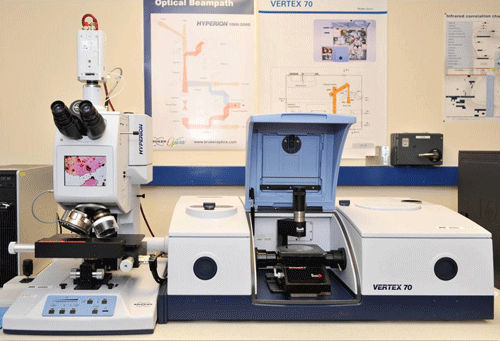To generate an IR spectrum requires access to a Fourier Transform Infrared (FTIR) spectrometer. Our current instrument (shown below) is a Bruker Vertex 70 instrument which covers the mid-infrared and far-infrared spectral regions. For most sample analysis, the mid–infrared region 4000-370 cm-1 is the preferred option since it is the most productive in terms of identification of different chemical functional groups. The far-infrared region (-) provides diagnostic information about a range of inorganic compounds including silicates, carbonates and sulphides but is less well investigated. Since it is a single beam instrument the sample spectrum is ratioed against a background spectrum which is essentially an instrument blank. The instrument is continuously purged with dry air to remove water vapour and carbon dioxide which increases signal energy since both are strong absorbers of IR radiation and also protects moisture sensitive optical components in the instrument. The routine sampling accessory is a Diamond Attenuated Total Reflectance (DATR) unit which requires minimum sample preparation and in many cases, none at all. Adjoining the left hand end of the main bench is a Bruker Hyperion 2000 FTIR Microscope which allows FTIR analysis of micro samples and very small areas across a sample, in transmission and reflectance modes, typically analysing a 100µm diameter spot and also has a micro ATR objective where only minimal contact with samples is required to produce a spectrum.



